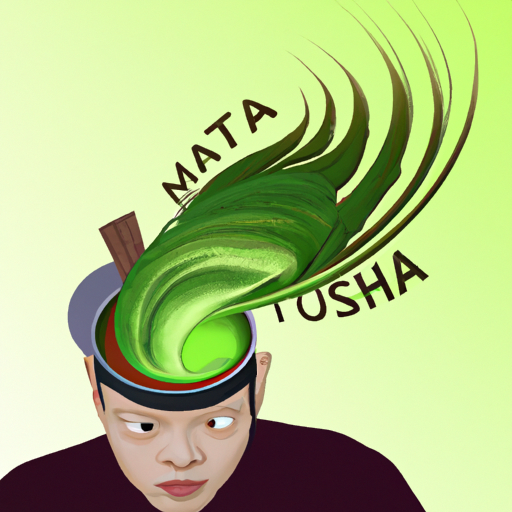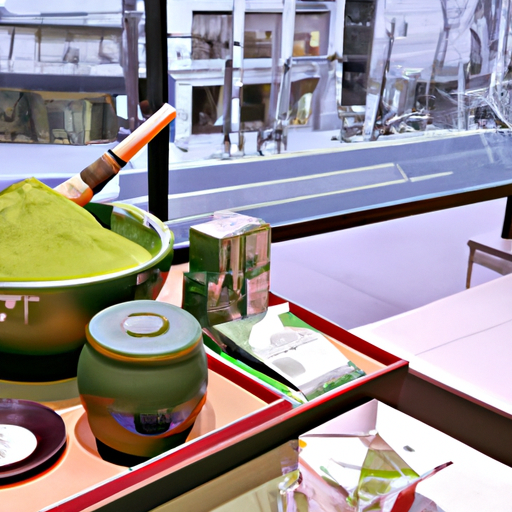Just like any other day, I made a cup of matcha tea for myself, looking forward to its energizing and focusing effects. However, the moment I tasted it, I was overwhelmed by a sensation of nausea, making me feel queasy and distressed.
This wasn’t the first time this had happened, and I couldn’t help but wonder, why does matcha make me nauseous?
Matcha has gained immense popularity in recent years, thanks to its numerous health benefits and unique flavor profile. But for some of us, consuming matcha can lead to unpleasant side effects like nausea, dizziness, and even vomiting.
In this article, we will explore the reasons behind this phenomenon and provide some tips on how to consume matcha without feeling sick.
Key Takeaways
- Matcha contains caffeine, which can cause jitters, anxiety, and nausea, especially if consumed in large quantities or on an empty stomach.
- Quality greatly impacts the overall effects of matcha on the body, and it is best made from young, tender leaves harvested in the spring and graded based on color, aroma, texture, taste, and aftertaste.
- Theanine promotes relaxation, but too much can cause nausea, and tannins can cause astringency leading to stomach discomfort, so it is essential to consume matcha in moderation and pay attention to how your body responds to it.
- Alternative ways to consume matcha include mixing into oatmeal, salad dressing, smoothies, or lattes, and pregnant women should limit caffeine intake to less than 200mg per day and avoid consuming matcha if experiencing morning sickness. Persistent nausea after consuming matcha may indicate an underlying medical condition, and seeking medical attention early on can help in the timely diagnosis and treatment of any health condition.
What is Matcha?
So, you’re probably wondering, "what exactly is matcha?"Well, let me break it down for you.
Matcha is a finely ground powder made from green tea leaves. It originated in Japan and is commonly used in tea ceremonies. Matcha is also used in various recipes such as smoothies, desserts, and even face masks due to its numerous health benefits.
One of the benefits of matcha for skincare is its high level of antioxidants. Antioxidants can protect against damage caused by free radicals, which can lead to premature aging. Matcha also contains chlorophyll, which has anti-inflammatory properties that can help calm irritated skin. In addition, the caffeine in matcha can help reduce puffiness and dark circles under the eyes when applied topically.
However, matcha can also be consumed as a beverage, and this is where the issue of nausea may arise. Matcha contains caffeine, and some people may be more sensitive to it than others. Too much caffeine can cause jitters, anxiety, and even nausea.
So, while matcha has many health benefits, it’s important to be mindful of your caffeine intake.
Caffeine Content in Matcha
If you’re sensitive to caffeine, matcha might be causing your queasiness. Matcha is made from ground green tea leaves, which contain caffeine. In fact, matcha has higher caffeine content than regular green tea because it’s made from the entire leaf, not just the brewed water.
The effects of caffeine on the body are well-known. Caffeine is a stimulant that can increase heart rate, blood pressure, and cause jitters or anxiety. However, some studies suggest that moderate caffeine consumption can actually have positive effects on heart health. Still, if you’re sensitive to caffeine, you may experience negative side effects such as nausea, headaches, or even heart palpitations.
Caffeine sensitivity varies from person to person. Some individuals are more tolerant of caffeine than others. If you’re experiencing nausea after consuming matcha, it may be a sign that you’re sensitive to caffeine. It’s important to listen to your body and consume matcha in moderation. If you’re concerned about your caffeine intake, talk to your doctor about what’s right for you.
Moving on to the next topic, the quality of matcha can also play a role in its effects on the body.
Quality of Matcha
However, the quality of matcha can greatly impact its overall effects on the body. Matcha cultivation and grading play a significant role in determining the quality of the final product.
Matcha is made from shade-grown tea leaves that are carefully harvested and processed, and the quality of these leaves can vary depending on the region, weather conditions, and farming practices. The best matcha is made from young, tender leaves that are harvested in the spring. These leaves are then steamed, dried, and ground into a fine powder.
The quality of matcha is determined by factors such as the color, aroma, and texture of the powder, as well as the taste and aftertaste of the tea. Matcha is graded based on these factors, with higher grades indicating a finer, more flavorful tea.
If matcha is of poor quality, it may contain impurities or be overly bitter and astringent, which can cause nausea and other digestive issues. It’s important to choose high-quality matcha from a reputable source to ensure that you’re getting a pure, flavorful tea that’s free from harmful contaminants.
Sensitivity to compounds in matcha can also contribute to nausea, as we’ll explore in the next section. The quality of matcha is an important factor to consider when consuming this tea. Matcha cultivation and grading can impact the taste, aroma, and overall effects on the body. By choosing high-quality matcha from a reputable source, you can enjoy all the benefits of this flavorful tea without experiencing any negative side effects. However, if you’re still experiencing nausea after consuming matcha, it may be due to sensitivity to certain compounds in the tea, which we’ll discuss in the next section.
Sensitivity to Compounds in Matcha
I’ve noticed that sometimes after drinking matcha, I experience nausea. After doing some research, I’ve learned that this could be due to my sensitivity to certain compounds present in matcha, such as theanine, tannins, and epigallocatechin gallate (EGCG).
Theanine is an amino acid that promotes relaxation and can make me feel calm, but too much of it can cause nausea. Tannins are naturally occurring compounds that can bind to proteins and cause astringency, which can also lead to stomach discomfort.
Theanine
You may be experiencing nausea from matcha due to the theanine, a natural amino acid found in the tea leaves. While theanine is typically praised for its calming effects and ability to improve focus, it can also cause unwanted side effects in some individuals.
Here are three key points to consider when it comes to theanine and matcha:
-
Theanine benefits: Theanine is known to increase alpha brain waves, which can create a feeling of relaxation without causing drowsiness. This can be helpful for reducing stress and anxiety, as well as improving mental clarity and focus.
-
Theanine sources: Matcha is one of the richest sources of theanine, containing up to five times more of the amino acid than other types of green tea. While this can be beneficial for some, it may lead to unpleasant side effects for others who are more sensitive to the compound.
-
Nausea and theanine: While theanine is generally considered safe, some people may experience nausea, headaches, or other digestive issues when consuming large amounts of the amino acid. If you find that matcha is causing you discomfort, it may be worth trying a different type of tea or reducing your intake to see if the symptoms improve.
Moving on to the next topic, tannins in matcha can also contribute to digestive issues in some individuals.
Tannins
While theanine in matcha is known for its calming effects, tannins found in matcha may cause some people to feel nauseous. Tannins are a type of polyphenol that are naturally occurring in tea leaves. They contribute to the astringency and bitterness of tea, as well as its color.
When consumed in high amounts, tannins can irritate the stomach lining and cause nausea or digestive discomfort. However, not all matcha has the same tannin content. Some matcha varieties are lower in tannins, while others are higher. If you find that matcha makes you feel nauseous, you may want to try a variety with lower tannin content, or switch to a different type of tea altogether that is lower in tannins, such as white or green tea.
Moving on to the next topic, epigallocatechin gallate (egcg)…
Epigallocatechin Gallate (EGCG)
Epigallocatechin gallate (EGCG) is a powerful antioxidant found in matcha that can help protect cells from damage, like a shield in a battle. It is one of the main active compounds in matcha, and some studies suggest that EGCG may have several health benefits, including reducing the risk of certain types of cancer, improving heart health, and aiding weight loss.
However, it’s important to note that most of these studies have been conducted on animals or in test tubes, and more research is needed to determine the long-term effects of EGCG in humans. While EGCG may have some health benefits, it can also have side effects, including nausea.
Some people may be more sensitive to the effects of EGCG than others, and consuming too much of it can lead to stomach upset. It’s important to consume matcha in moderation and pay attention to how your body responds to it. Other factors that may cause nausea include caffeine content, additives or sweeteners, or the quality of the matcha.
Other Factors That May Cause Nausea
Additionally, consuming matcha on an empty stomach or in large quantities may also lead to feelings of nausea. However, other factors can also contribute to this unpleasant sensation.
For instance, certain food combinations can trigger nausea when consumed alongside matcha. Hydration also plays a role, as dehydration can cause nausea and matcha’s caffeine content can be dehydrating.
Moreover, some individuals may be more sensitive to the caffeine content in matcha, which can cause nausea as a side effect. It’s important to note that matcha contains more caffeine than regular green tea, and the caffeine levels can vary depending on the quality and preparation of the matcha. Additionally, matcha contains small amounts of tannins, which can cause digestive discomfort in some people.
While consuming matcha on an empty stomach or in large quantities can contribute to feelings of nausea, other factors such as food combinations, hydration, caffeine sensitivity, and tannin content can also play a role. Understanding these factors can help individuals better manage their matcha consumption and minimize the risk of experiencing nausea.
In the following section, we’ll discuss some tips for consuming matcha in a way that maximizes its benefits while minimizing any potential side effects.
Tips for Consuming Matcha
To fully enjoy the benefits of matcha and avoid any unwanted side effects, try implementing these tips into your daily routine. Firstly, make sure to purchase high-quality matcha from a trusted source. This will ensure that you are consuming a product that is free of contaminants and has a rich flavor. Additionally, try experimenting with different matcha recipes to find one that suits your taste preferences. Matcha can be incorporated into smoothies, baked goods, and even savory dishes.
Secondly, pay attention to the way you prepare your matcha. One common mistake that people make is using water that is too hot, which can lead to a bitter taste and upset stomach. Instead, use water that is around 175°F (80°C) and whisk the matcha powder gently in a zigzag motion until it’s smooth and frothy. This will result in a smooth, creamy texture that is easy to drink and digest.
Lastly, consider the timing and frequency of your matcha consumption. Drinking too much matcha too quickly can be overwhelming for your body, leading to nausea and other digestive issues. Start by consuming a small amount of matcha each day and gradually increase the amount over time. Additionally, try to drink matcha on an empty stomach, as this will allow your body to fully absorb the nutrients and antioxidants in the tea.
Incorporating these tips into your matcha routine can help you avoid any unwanted side effects and fully enjoy the benefits of this superfood. For more ideas on how to consume matcha, continue reading about alternative ways to incorporate this tea into your daily life.
Alternative Ways to Consume Matcha
Looking for new ways to enjoy matcha? Try mixing it into your morning oatmeal or adding it to your favorite salad dressing for an extra boost of antioxidants.
Another great way to enjoy matcha is by making a matcha smoothie or a matcha latte. These drinks are not only delicious, but they also provide a healthy and energizing alternative to your usual morning coffee.
To make a matcha smoothie, simply blend matcha powder with your favorite fruits, yogurt, and milk or plant-based milk. The result is a creamy and refreshing drink that is perfect for a hot summer day.
If you prefer something warm and comforting, try making a matcha latte by whisking matcha powder with hot milk and sweetener of your choice. It’s a great way to start your day and it can also help reduce nausea if you’re sensitive to the taste of matcha.
In addition to trying new ways to consume matcha, it’s important to ensure that your nausea is not caused by an underlying medical condition. If you continue to experience nausea after consuming matcha, it may be a good idea to consult with a healthcare professional to rule out any potential medical issues.
Medical Conditions That May Cause Nausea
I want to discuss two medical conditions that can cause nausea: acid reflux and pregnancy. Acid reflux occurs when stomach acid flows back up into the esophagus, causing discomfort and potentially nausea.
Pregnancy can also cause nausea, commonly known as morning sickness, due to hormonal changes and increased sensitivity to certain smells and tastes.
Understanding the causes of nausea can help in managing and treating these conditions.
Acid Reflux
Acid reflux can cause intense discomfort and a feeling of sickness, making it difficult to enjoy the unique taste of matcha. To minimize symptoms, it’s best to consume matcha in small amounts and avoid consuming it on an empty stomach. Drinking matcha with a meal that is low in fat and acid can also help reduce symptoms.
Natural remedies for acid reflux and nausea can be effective in reducing discomfort. For example, ginger tea has anti-inflammatory properties that can help relieve symptoms of acid reflux. Peppermint tea has a similar effect and can also promote healthy digestion. However, it’s important to note that not all natural remedies are safe for everyone, and it’s best to consult with a healthcare professional before trying any new remedies.
As we move on to the next section about pregnancy, it’s important to understand how acid reflux can impact expectant mothers.
Pregnancy
Pregnancy can be an exciting and joyous time, but the thought of consuming matcha may make you hesitant due to its potential impact on your developing baby. As a pregnant woman, you may experience morning sickness, making it difficult to consume certain foods and drinks. Matcha, known for its high caffeine content, may exacerbate nausea and vomiting, making it an unfavorable choice during pregnancy.
To ensure the safety of your developing baby, it’s important to follow dietary restrictions during pregnancy. Consuming matcha may increase the risk of complications during pregnancy, such as preterm labor and low birth weight. It’s recommended to limit caffeine intake to less than 200mg per day during pregnancy. If you’re experiencing morning sickness, it’s best to avoid consuming matcha altogether and opt for other non-caffeinated beverages.
It’s important to consult with your healthcare provider for personalized recommendations on matcha consumption during pregnancy.
In the next section, I’ll discuss when it’s necessary to seek medical attention for matcha-related nausea.
When to See a Doctor
If you’re experiencing persistent nausea after consuming matcha, it may be necessary to seek medical attention to rule out any underlying health conditions. While matcha may cause some people to feel nauseous, there are other possible causes of nausea unrelated to matcha.
For instance, individuals who have an underlying medical condition like acid reflux, ulcers, or gallbladder disease may experience nausea after consuming matcha. If the nausea persists even after discontinuing the use of matcha, it’s essential to see a doctor.
Other symptoms like vomiting, abdominal pain, and loss of appetite may also indicate an underlying health condition. During the appointment, the doctor may perform some tests to determine the cause of the nausea. These tests may include a physical exam, blood tests, urine tests, and imaging tests like an ultrasound or endoscopy.
It’s important to remember that persistent nausea should not be ignored, as it may indicate a severe underlying condition. Seeking medical attention early on can help in the timely diagnosis and treatment of any health condition. Therefore, if you experience persistent nausea after consuming matcha or any other food or drink, it’s essential to see a doctor and get the necessary medical attention.
Frequently Asked Questions
Can matcha be consumed by pregnant women?
Are you wondering if matcha is safe to consume during pregnancy or while breastfeeding? The answer is not straightforward. While matcha has numerous health benefits, it also contains caffeine and other compounds that could potentially harm the developing fetus or nursing infant.
Some studies suggest that high doses of caffeine during pregnancy may increase the risk of miscarriage, preterm birth, and low birth weight. Additionally, matcha may interact with certain medications or supplements that are commonly used during pregnancy.
Therefore, it’s best to consult with a healthcare provider before consuming matcha during pregnancy or while breastfeeding. They can help you weigh the potential risks and benefits and make an informed decision that is best for you and your baby.
How does matcha differ from other green teas?
Matcha differs from other green teas in a few ways. Firstly, the processing methods are unique. Matcha tea leaves are grown in the shade for several weeks before being harvested, steamed, and dried. The leaves are then ground into a fine powder, which is what gives matcha its characteristic green color and unique flavor.
This process also increases the caffeine content of matcha, as the shade-grown leaves produce more caffeine. In fact, a cup of matcha contains about three times as much caffeine as a cup of regular green tea. This high caffeine content can be a factor in why some people experience nausea after consuming matcha. However, there may be other factors at play, such as individual sensitivity to caffeine or other components of the tea. It’s always best to consult with a healthcare provider if experiencing persistent nausea or other adverse side effects from consuming matcha.
Is it safe to consume matcha on an empty stomach?
I’ve found that consuming matcha on an empty stomach can be safe, but it’s important to consider the possible effects of caffeine. Matcha contains caffeine, which can stimulate the digestive system and cause discomfort for some individuals when consumed on an empty stomach.
However, matcha also offers numerous health benefits, including antioxidants and amino acids that can improve cognitive function, boost metabolism, and enhance overall well-being. It’s important to consider personal tolerance to caffeine and matcha benefits before deciding when and how to consume it.
If you experience nausea or discomfort after drinking matcha, it may be helpful to consume it with food or reduce the amount of caffeine in your diet.
Can matcha cause heart palpitations or anxiety?
As someone who loves matcha, I’ve experienced heart palpitations and anxiety after drinking it. This is because matcha contains caffeine, which can cause these symptoms in some people.
Additionally, some individuals may have a sensitivity to caffeine or experience digestive issues after consuming matcha. It’s important to note that while matcha has many health benefits, it may not be suitable for everyone.
If you experience these symptoms after drinking matcha, it’s best to consult with a healthcare professional to determine the underlying cause and whether or not matcha is right for you. As the adage goes, "everything in moderation,"and this applies to matcha consumption as well.
Does the water temperature affect the taste and effects of matcha?
Water temperature impact is a crucial factor in matcha preparation that can affect the taste and effects of the tea. Generally, matcha is best prepared with water at a temperature of around 175°F, as this temperature allows for the full release of the tea’s flavor and nutrients without burning the leaves.
Using water that’s too hot can result in a bitter taste, while water that’s too cold may not extract enough flavor. Additionally, matcha quality grading can also impact the taste and effects of the tea.
Higher quality matcha, such as ceremonial grade, is typically smoother and more flavorful than lower quality matcha. Overall, paying attention to the water temperature and matcha quality grading can greatly enhance the matcha drinking experience.
Conclusion
So, why does matcha make me nauseous? After researching and consulting with experts, it seems that there are several factors that contribute to this unpleasant side effect.
It could be due to the quality of the matcha, the caffeine content, or even a sensitivity to compounds found in the tea. As someone who’s experienced nausea after consuming matcha, I can relate to the frustration and disappointment of not being able to fully enjoy this trendy beverage.
However, with some helpful tips and alternative ways to consume matcha, it’s possible to still reap the health benefits without feeling sick. In conclusion, while matcha may not be for everyone, it’s worth exploring and experimenting with different types and methods of consumption.
With an open mind and a willingness to adjust, matcha can be a delicious and nutritious addition to your diet. As the saying goes, "when life gives you lemons, make lemonade."So, when matcha makes you nauseous, try making a matcha latte with almond milk or adding a scoop to your morning smoothie for a boost of energy and antioxidants.










